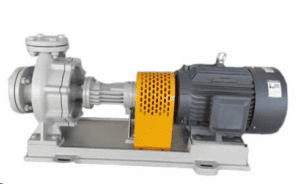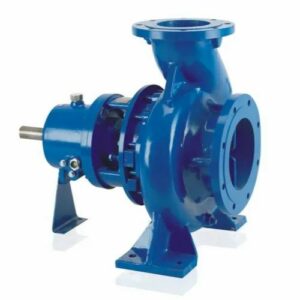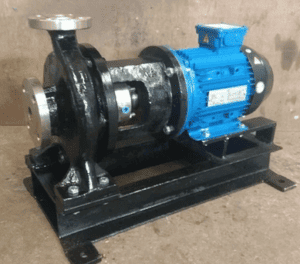Thermal Oil Transfer Pump
What is a thermal oil transfer pump?
A thermal oil transfer pump is a particular type of centrifugal pump with a stainless-steel or cast-steel construction that is mainly used for hot oil circulation and transfer. It primarily applies in closed systems where hot oil is used to directly transfer heat without creating hot spots, which can damage the product through thermal cracking, thermal decomposition, or solidification. Thermal oil pumps help to ensure uniform heating at high-temperature conditions where it is not possible to have direct heat when flammable liquids such as heavy fuel oils are being handled. Thermal oil transfer pump manufacturers usually seal the units hermetically and design the housing to withstand pressure as high as 50 bars and fluid temperatures up to 350 degrees. It is evident in oil burners, furnaces, industrial boilers, or systems. Thermal oil pump provides attractive performance characteristics with a pump capacity of up to 450 cubic meters per hour, a maximum pressure head of 100 meters, and a pump speed of 2900 rpm.

Figure: Showing the configuration of a thermal oil transfer pump
Components of a thermal oil transfer pump
Electric motor
The thermal oil transfer pump utilizes an ATEX-approved electric motor to safeguard against explosion under high temperature and pressure conditions. The electric motor provides the mechanical energy to run the pump. It converts electrical energy into mechanical torque output, which is then transmitted to the pump head via the pump shaft and coupling.
Pump housing
The pump housing contains the pump’s internal components, such as the impeller, shafts, and bearings housing. It also serves as a pressure containment vessel and carries the suction and discharge ports which help to direct the fluid into and out of the pump ports. Thermal transfer pump manufacturers create the pump body using stainless steel grade 304, cast steel, or cast iron.
Shaft
The shaft is a rotary mechanical component supported on bearings. Its main functions are to carry the impeller. It is usually made from stainless steel and is connected to the prime mover via a flexible or rigid coupling.
Impeller
The impeller is a rotor that serves the role of increasing the kinetic energy and pressure of the fluid. It is usually mounted on the pump shaft and housed in the pump casing. It is fitted with a series of backward-curved vanes.
Bearings
The primary purpose of the bearings is to support the rotor and to align them correctly with the fixed ends under the action of radial and axial forces. The thermal oil transfer pump manufacturers fit the devices with rolling ball bearings to contain the relative motion of the rotor assembly.
Suction inlet and discharge outlet
The fluid enters the thermal oil transfer pump through the suction inlet and exits through the discharge outlet.
How does a thermal oil transfer pump work?
When the motor turns on, the pump shaft rotates the impeller at a very high speed. The centrifugal effect of the rotating pump impeller creates a vacuum inside the pump casing, which allows the high-temperature oil to enter through the pump inlet. When the oil strikes the impeller blades, the centrifugal force moves it radially and axially outwards while imparting great kinetic energy until it enters the diffusing chamber at a very high velocity. In the diffuser, the extreme kinetic energy converts into a high-pressure head, and then the oil is directed into the discharge pipe, where it flows to the designed location.

Figure: Working of a thermal oil transfer pump
Types of thermal oil transfer pumps
Stainless steel thermal oil transfer pump
In this pump, all the wetted components feature stainless steel grade 304 construction. The corrosion-resistant material enhances the pump’s durability and performance. This pump can handle oil containing abrasive particles and corrosive, viscous fluids.
Figure: Showing a stainless-steel thermal oil transfer pump.
End suction thermal oil transfer pump
An end suction thermal oil transfer pump draws thermal oil axially into the suction and discharges it at 90 degrees to the suction. The pumped fluid usually comes in from one side of the pump and discharges from the top. End suction thermal oil pump can be either frame mounted or close-coupled to the pump body. Depending on the application, this type of pump can be driven using an electric motor or diesel engine. It has a low initial cost.
Figure: Showing an end suction thermal oil transfer pump.
Single suction thermal oil transfer pump
In this pump, the thermal oil enters the impeller from one side and exits from the other. The single suction thermal oil transfer pump offers a smooth operation and is easy to repair.
Double suction thermal oil transfer pump
In a double suction thermal transfer pump, the pumping fluid enters either side of the impeller and exits from the middle section. As the liquid enters from both sides of the double suction impeller, the axial thrusts on either side effectively cancel out. This pump, therefore, is less susceptible to wear and tear caused by axial thrust and can last longer. It also reduces cavitation because of the reduced inlet speed.
Figure: Showing a double-suction thermal oil transfer pump.
Applications of thermal oil transfer pumps
The thermal oil transfer pump is extensively used in many industrial systems, such as hot oil circulation, oil burners, furnaces, and boiler feed. They are also widely used on the offshore platform and for boiler systems on board a ship or vessel.
- Thermal oil transfer pumps are used to transfer hot oils for heating purposes or hot oil to oil burners.
- It is used as a circulation pump in industrial heating systems to handle heat transfer oil up to 350 degrees.
- They are used to pump thermal oils at high temperatures without external cooling.
- They are used to feed oil burners or as an oil circulation pump for circulating heating oil as part of an extensive boiler feed system.
Advantages of a thermal oil transfer pump
- Thermal oil transfer pumps provide optimal performance and require minimal maintenance time.
- They can handle oil and temperatures of up to 350°C.
- They have minimal life cycle cost and excellent reliability.
- They have high energy and operating efficiency.
- They have a simple and compact structure, which is easy to install and maintain.
- They utilize ATEX-approved motors for potentially explosive environments.
- They can manage high flow rates of up to 8300 liters per minute at a pressure of up to 50 bar; thus, it is perfect for applications requiring high pressure and large flow.
- They are perfect for low and high-viscosity thermal oils up to 50,000 CP.
- They are available with a double mechanical seal system to allow cooling of the seals.
- They can work with various thermal oil oils, including, Duratherm, Paratherm, and many more.
- They provide a steady and continuous output.
Disadvantages of a thermal oil transfer pump
- An intense load can fail the thermal oil transfer pump.
- They are subject to cavitation.
- It has limited suction power due to the use of rotational speed.
- They are prone to leakage due to weary gaskets.
- Qualified personnel must maintain the high pressure and temperature device when needed.
- The heat transfer oils of thermal oil systems are harmful to the environment and thus require the use of safety heat exchangers, special shaft seals and valves, and spill troughs with leakage detection in every joint.
Troubleshooting a thermal oil transfer pump
The pump fails to start
- There is a blown-out fuse or tripped circuit breaker. Inspect the thermal oil transfer pump for a blown-out fuse and replace it if necessary.
- The power supply to the panel is insufficient. Ensure the motor receives the proper voltage and current according to the thermal oil transfer pump manufacturers’ guide.
Zero discharge after startup
- There is air in the pump or suction pipework. Vertical inline centrifugal monoblock pumps cannot prime with air on the suction side. Ensure that the pump or pipework is filled with water to drive out the air from the pump system.
- The inline pump operation is reversed. Check that the direction of the motor rotation matches the direction of the thermal oil transfer pump manufacturer’s arrow on the pump casing. Reverse the motor polarities.
- The check valve is fitted incorrectly. Install the check valve properly or replace it.
- The pump’s monomeric head is insufficient due to high friction losses exceeding the pump design. Be sure to raise the pump power to the level recommended by the thermal oil transfer pump manufacturers. Open all the valves and ensure the delivery pipes are of the correct sizes.
- The pump inlet is blocked. Clear the channel of any obstruction.
- The impeller or check valves are clogged. Clear any blockage from the impeller and the valves.
The pump is vibrating excessively
- The impeller is severely worn-out. Inspect and replace the impeller with another one from the thermal oil transfer pump manufacturer if you find it fit.
- There is excessive thrust due to mechanical failure. Inspect the pump assembly and correct any shortcomings.
- The pump shaft is oblique or unbalanced. Inspect the post, rebalance it as required, or replace it.
- There are unbalanced components in the pump. Inspect and rebalance the thermal oil transfer pump components as necessary.
- The shaft is bent. Dismantle and replace the shaft if necessary.
The pump is noisy
- The rotating part rubs on the stationary component. Dismantle the pump and correct the rotor assembly.
- Some pump parts are loose. Tighten the components to the torque level recommended by the thermal oil transfer pump manufacturers.
- Some pump components are excessively worn-out. Inspect the rotor assembly for worn-out bearings or impellers and replace them if necessary.
- The pump is working in cavitation. Ensure that the net suction pressure head meets the thermal oil transfer pump manufacturer’s specifications. Be sure to open the suction line valves fully.
- The pump is working outside the duty range. Ensure the correct duty range according to the thermal oil transfer pump manufacturer’s manual.
Bearings have a short life
- There is excessive cooling of the water-cooled bearing, resulting in condensation of atmospheric moisture in the bearing housing. Reduce the flow of cooling water.
- The shaft is bent. Inspect and replace the shaft if necessary.
- The bearings are worn-out due to the shaft running out. Replace them if necessary.
- The rotating components are rubbing against the stationary part. Correct the assembly.
The pump driver is overloaded
- The pump’s speed is too high. Lower the pump speed.
- There is mechanical friction within the pump. Inspect the pump assembly for any obstruction or deflection.
- Wrong voltage supply. Check that the pump receives the proper voltage following the thermal oil transfer pump manufacturer’s guide.
- The density and viscosity of the thermal oil exceed the pump design. Ensure that the thermal oil transfer pump suits the particular application.
Summary
A thermal oil transfer pump is an edge-cutting centrifugal device featuring a stainless-steel or cast-steel construction that is mainly used for hot oil transfer and circulation. Thermal oil transfer pump manufacturers usually design the units to be hermetically sealed with a pump casing capable of withstanding high pressure and temperature. Thermal oil transfer pump mainly applies in closed systems to directly transfer hot oil without causing hot spots, which can damage the product through thermal cracking, thermal decomposition, or solidification. Thermal oil transfer pumps are evident in many industrial systems, such as hot oil circulation, oil burners, furnaces, and boiler feed. They are also found in the offshore platform and boiler systems on board ships or other marine vessels. Thermal oil transfer pumps provide optimal performance and require minimal maintenance time. These units also have minimal life cycle costs and excellent reliability. The use of ATEX-approved motors enhances the applicability of thermal oil transfer pumps in potentially explosive environments.



